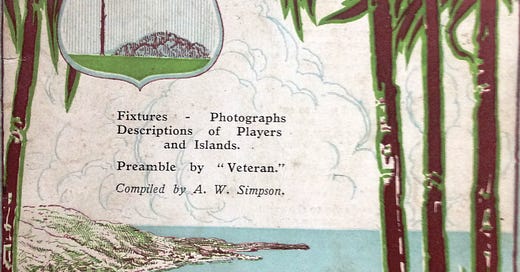Ah, the evocative charm of cricket past, captured in the pages of a souvenir programme! One can almost hear the rustle of the crowd, the crack of leather on willow, as one delves into the West Indies tour of England in 1933.
One is struck first by the splendid colour print adorning the front cover, and then by how long was the tour itself—a veritable cricketing marathon, commenced on the 28th of April in Gravesend, and concluded on the 12th of September at the picturesque Scarborough.
As a proud Yorkshire member, my eyes naturally seek out the date when the West Indies clashed with Yorkshire, which turns out to have been the 5th of July. Fresh from a drawn match against Lancashire, the tourists faced a White Rose side buoyed by victory over Surrey. This encounter was particularly notable as marking the West Indies’ first visit to Harrogate since 1906, when Lebrun Constantine, father of the legendary Learie, graced the field.
Yorkshire were without their stalwart bowlers Bill Bowes and George Macauley, and winning the toss, elected to bat before a crowd of approximately 9,000 eager spectators. It is surprising to see Percy Holmes listed at three, with Wilfred Barber joining the indomitable Herbert Sutcliffe to open the innings. Constantine jnr, bowling with fiery pace on a slow wicket, swiftly dispatched Sutcliffe and Holmes, leaving Yorkshire in precarious straits. But Arthur Mitchell, with a painstaking innings of 94 not out, retrieved the situation to a respectable 240 by day’s end.
The Caribbean response was swift but faltering: They were bowled out in just fifty overs. George Headley, the “Black Bradman,” top-scored with a mere 25, as Hedley Verity’s masterful off-breaks wrought chaos, dismissing the visitors for 115.
Yorkshire’s second innings saw Mitchell (below) again at the helm, contributing an unbeaten 67 to a total of 248 in 67 overs. Verity continued his dominance on the third day, taking seven wickets for 57 runs, while local hero Thomas Smailes, born in Harrogate, chipped in with three for 38. The West Indies, bowled out for 173 in seventy overs, succumbed to a defeat by 200 runs.
Yorkshire’s triumph in this match was a stepping stone to their Championship victory that year. The visitors, despite their spirited efforts, managed only five wins on the tour and lost the Test series two-nil. It was a swan-song season for Percy Holmes, who, at forty-six, bid farewell to first-class cricket at its conclusion. Meanwhile, a young Len Hutton was making waves in the Second XI…
I do love scorecards. Each tells a tale, often an epic one. Each match is a thread in the rich tapestry of our sport.
Brian Sanderson is an ACS member. He serves on the Yorkshire Cricket Archives Committee. If you would like to contribute to this newsletter, please either respond to the email in which you received it, or leave a comment below.







*its unique tempo:)
Can I just say, I really appreciate this blog! Really, really cool to delve into the history of our great sport in these bite-sized chunks :)
Amazing to think of the length of this tour, compared to today when Test series are as compressed as possible, before the players jet off to their T20 franchises.
And yet there's something timeless about taking in a game of cricket and enjoying it's unique tempo - in that regard, I dare say, even a spectator at the IPL is not that different to a Yorkshire fan watching his team against West Indies in 1933. Every game will have the act of a bowler walking back to the mark, the batsman tapping the bat on the crease and the crack of willow on the ball, over and over again. And that's beautiful, one of the greatest things in the world:)